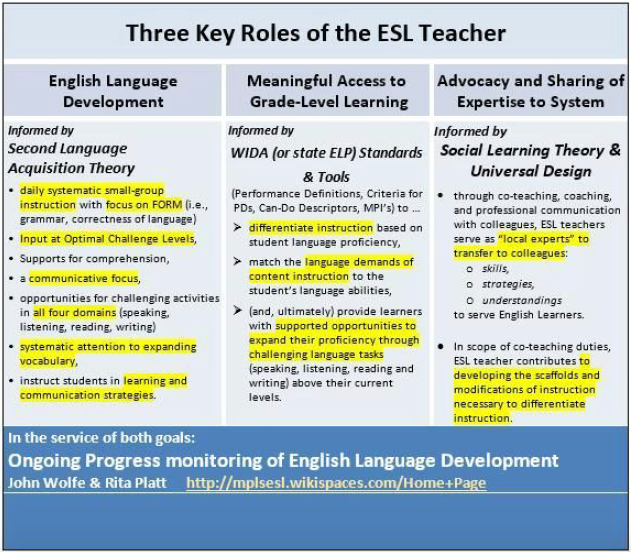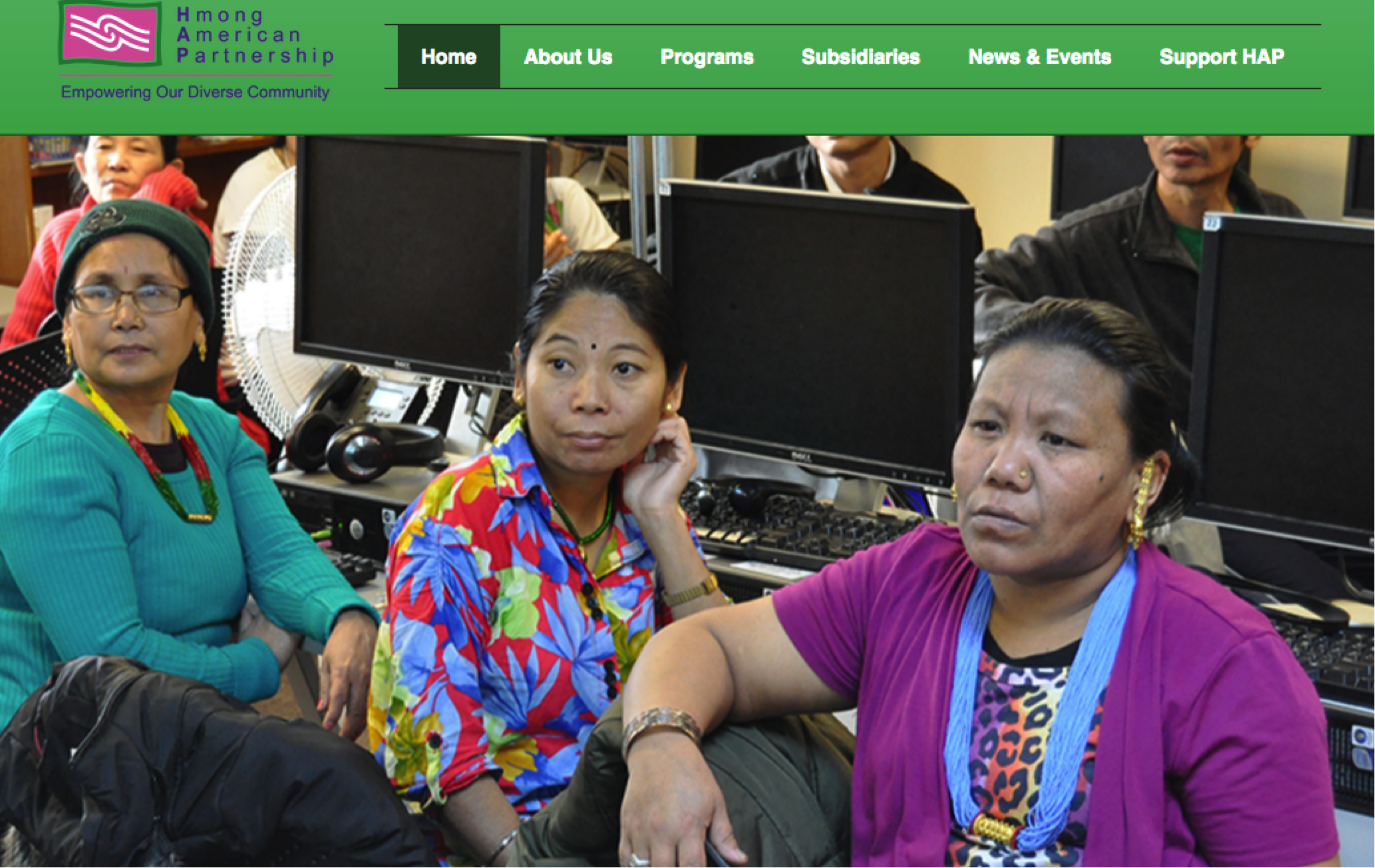ESL teachers share their perspective that ESL teachers often serve in three key professional roles in the K-12 instructional setting: supporting systematic English language development, supporting access to grade-level content learning, and serving as an advocate and local expert to support colleagues in meeting the needs of English learners.
Not too many years ago, the K-12 ESL classroom was a space apart. It served as a warm refuge from what were often the unreasonable demands of the rest of the school day. These classrooms were their own corner of the school characterized by diversity, acceptance, and comprehensible input. Sounds good, right? And, maybe it was good while the students were in that little peaceable kingdom.
So, why did many ESL teachers become uncomfortable with the system as it was? They realized that creating a space apart for ESL services did not meet the learning needs of English learners (ELs) as they navigated the rest of the school or out in the wider world. Teachers realized that students did not need a refuge from the world as much as they needed tools and advocacy to be successful there.
Today the roles and responsibilities of the ESL teacher have been greatly broadened. Sometimes that broadening means stretching the work of ESL teachers into the wrong places. ESL teachers are called to work as on-call emergency substitutes, math tutors, assistant principals, interpreters, and glorified paraprofessionals; they often become the utility infielders for the entire school.
What is the rightful role of an ESL teacher? Concisely put, it is to help students learn English. That seems obvious, but in schools all over the country, it is often overlooked in favor keeping “the system” running smoothly. A recent move toward co-teaching in content classes has exacerbated this problem as the ESL teacher can be treated as an extra hand. As such, ESL teachers too often are trapped into serving as grease for the wheels of systems that habitually fall short of meeting the needs of ELLs. ESL teachers find themselves helping students finish homework and complete assignments. At times, they find themselves providing “assessment accommodations” that devolve into coaching students through tests in ways that can make all uncomfortable. This is done to help ESL students pass content classes that often do not recognize their unique learning needs. On one hand, this makes a lot of people feel better. The students pass their classes. The teachers are not forced to fail them. The parents see their students getting good grades. But, on the other hand, ultimately the learning needs of the students are not being served. The actual achievement gap does not narrow. There are still too many long-term learners. Too many dropouts. Too many students who are not career or college ready.
What is the remedy? How does the profession fix this? A good start is for ESL teachers to embrace and grow into the three key roles. Each role is situated around a key function:
- Supporting systematic English language development.
- Supporting access to grade-level content learning.
- Serving as advocates and local experts to support colleagues and the school in better meeting ELLs needs (see Figure 1).

Role 1: Support English Language Development (ELD)
While it may be controversial, the profession must consider a systematic approach. Students at all levels of language proficiency need systematic stand-alone ELD instruction. The convergence of the research indicates not just the efficacy but also the absolute need for a pullout class with a dedicated ESL teacher for 30 to 45 minutes of every day. For example, Saunders, Guldenberg, and Marcelletti’s (2013) synthesis of the research on English Language Development draws the conclusion that despite the profession’s commitment to communicative language teaching, teaching approaches grounded in this perspective are simply not enough. They write, “Second language acquisition teachers, theorists, and researchers have realized that exposure and interaction might help promote fluency and communicative competence, but they are not sufficient for native-like proficiency” (p. 14). Since native-like proficiency is what will provide ELLs with access to traditional paths to success, the authors go on to recommend that “ELD instruction should continue at least until ELs attain advanced English language ability” (p. 16).
Saunders et al. go on to offer conclusions drawn from empirical research on ELD, which adds up to a strong endorsement of a return to what many teachers might think of as old-school language teaching. Saunders et al. specifically suggest that, “A separate, daily block of time should be devoted to ELD instruction” (p. 17) that “explicitly teach[es] forms of English (e.g., vocabulary, syntax, morphology, functions, and conventions)” (p. 18).
Role 2: Provide Meaningful Access to Grade-Level Content Learning
This is where co-teaching comes in. ESL teachers know that their students’ language abilities are an asset. They also know that their students are capable of learning grade-level content. But, to make it happen the ESL teacher has to work to make sure that learning targets are clear, teaching is comprehensible, and the assignments, activities, and assessments are appropriate to the students’ language abilities.
The struggle is that mainstream content teachers have an impulse to maximize the content they teach which can drown the specific standards-based learning targets and leave ELLs in the dust. Part of the role of the ESL teacher is to help content teachers tighten their focus and pinpoint the most important learnings so that we can help scaffold and differentiate to meet ESL needs. The best way to do this is to start with state standards. Williams, Hakuta, Haertel and their research team (2007) reported on an analysis correlating ELs’ performance on state reading, math and English proficiency accountability tests with a wide variety of school practices and beliefs. In a large-scale study (257 elementary schools, 1,400 teachers and all ELs at the buildings), “coherent standards-based instruction” was identified as the third-strongest factor associated with higher scores, and the only factor with essentially equal positive effects on both EL’s and non-ELs (p.17). As working ESL teachers know, this places a large burden at their feet. In essence, to support ELLs and content teachers in serving them, ESL teachers have to master the standards in every content area and grade they work with. Standards identify the key understanding that students should achieve as the result of instruction. Thought it will take time and effort, it is worth it in the end. What teachers do not have time to do is to support teachers in instruction that is not standards-based, this type of on the fly or off the map teaching does not fit the co-teaching model.
When ESL teachers know the standards, they can help the content teacher focus on them and apply WIDA (2014) tools and supports to maximize student growth in content vocabulary and knowledge. This can be a sticking point with content teachers. They are afraid their lessons, assignments, and assessments lose rigor when the language demands are modified to meet the needs of ELs. ESL teachers know that is not the case. ESL and content teachers must work together, using the Can-Do Descriptors to plan for comprehensible input and to ensure that the activities and assessments we use with ELs are appropriate, learning focused, and still rigorous. When instruction is focused on standards co-teachers can work together to plan lessons even when they do not have extended collaborative time.
Role 3: Capacity Building and Advocacy
This is the newest role of the ESL teacher and an incredibly important one. A content teacher’s job is increasingly difficult. There seems to be a never-ending bevy of mandates, initiatives, evaluations, pilot-programs, and assessments. This trend gives no indication of changing soon. On a positive note, one of the best recent trends in education is a focus on meeting the individual needs of students through differentiated instruction, however, most of that has focused on helping native English speakers who are below grade level. Meeting the needs of ELs, however, requires a unique set of skills to differentiate for diverse language learners from various backgrounds and with wide-ranging proficiency levels. Classroom teachers cannot manage it all alone. Part of an ESL teacher’s job is to serve as an expert. ESL teachers must not be afraid to share expertise. They are specially trained and have knowledge and skills to serve ELs that most mainstream teachers simply do not have. They must include in their goals being a resource to all who serve English language learners.
Hansen-Thomas, Dunlap, Casey, and Starrett (2014) highlight the potential of this shared expertise in an article describing the results of an innovative program designed to provide content teachers with accelerated, intense training in “multicultural competence, second language acquisition, and ESL teaching strategies” (p. 35). The article’s conclusion is clear; there are great benefits when content teachers have more insight into best practices in ESL. The authors state, “These newfound [content teachers who are also] ESL experts began to advocate for the needs of their ELLs, working for the best interests of their students and promoting appropriate practices such as research-based strategy use, understanding the implications of standardized testing, and knowing and showing how best practices for ELLs can promote their success” (p. 44). The implication is clear: deeper understanding of the challenges ELLs face and of how to support them results in greater instructional efforts to serve them. This result strongly argues for a greater prioritizing of the ESL teacher’s role as a teacher of colleagues.
Again, this means that the goal of co-teaching cannot just be to bolster student success it must also be to transfer skills, strategies, and understandings to classroom teachers so that they themselves can serve language learners well. Additionally, ESL teachers must be loud and proud advocates for students’ needs inside and outside of the classroom. An example from comes from Stephen Krashen (2015), one of the profession’s strongest and most vocal advocates for the educational rights of ELs. In a blog post titled The ELL “Problem” and the Common Core “Solution” he responds to the claim that ELLs are not making progress on state accountability Math and Reading measures. Confronting this point head on, Krashen argues that “We would not expect ELLs as a group to ‘improve’; when ELLs make sufficient progress, they are reclassified as non-ELL. The group average test score should stay about the same.” Krashen admirably models here a style of advocacy for ELs that is strong, committed, and informed by clear educational thinking. This is another situation where ESL teachers need broad expertise about community resources and issues that surround the ESL community.
The three roles of the ESL teacher are daunting. The work of an ESL teacher is hard. Nevertheless, there may not be a more important job or a job more in sync with the American dream. Through embracing their roles as teachers of ELD, co-teachers for content instruction, and expert-advocates in the system, this seemingly overwhelming challenge can be more realistically addressed. An ESL teacher’s job is not to make either their students or their colleague’s jobs easy. These jobs are hard by their very nature. The role of the ESL teacher is to make these jobs possible.
References
Hansen-Thomas, H., Dunlap, K., Casey, P., & Starrett, T. (2014). Teacher development: De facto teacher leaders for English language learners. International Journal of Learning, Teaching and Educational Research, 5(1), 35-47.
Krashen, S. (2105). The ELL “problem” and the Common Core “solution” Retrieved from http://skrashen.blogspot.com/2015/07/the-ell-problem-and-common-core-solution.html#
Saunders, W., Goldenberg, C., & Marcelletti, D. (2013). English language development guidelines for instruction. American Educator. Retrieved from https://www.aft.org/sites/default/files/periodicals/Saunders_Goldenberg_Marcelletti.pdf .
WIDA: Can-do descriptors. (2014). Retrieved from https://www.wida.us/standards/CAN_DOs/
Williams, T., Hakuta, K., Haertel, E., et al. (2007). Similar English learner students, different results: Why do some schools do better? A follow-up analysis, based on a large-scale survey of California elementary schools serving low-income and EL students. Mountain View, CA: EdSource.







